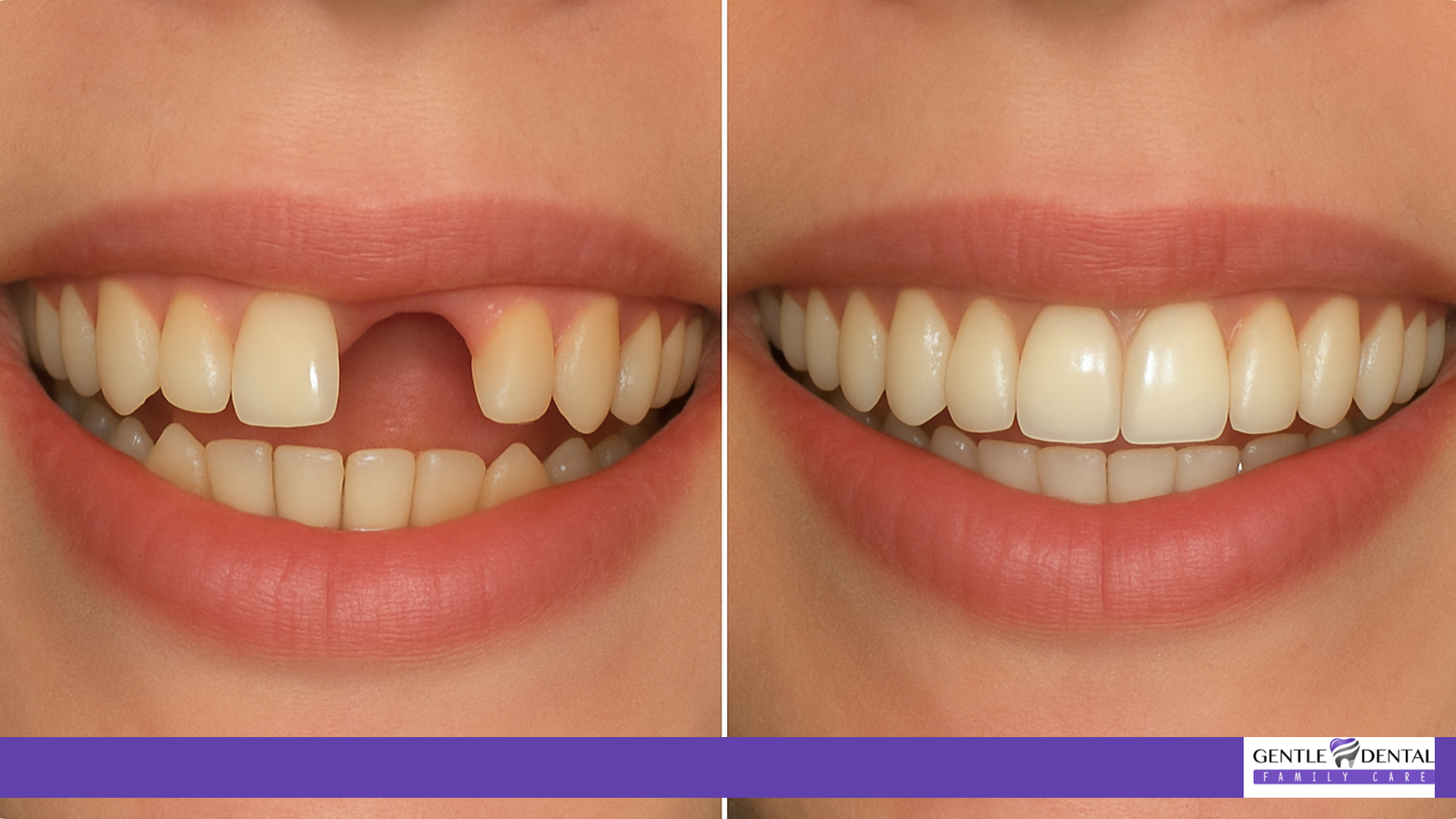A confident smile is a powerful tool. Whether you’re meeting new people or sharing precious moments, your smile helps you connect with the world. But what happens when dental issues, such as missing teeth, get in the way? That’s where dentures and partials come in. But what are dentures and partials, and how can they help you restore your smile?
Our comprehensive guide will walk you through everything you need to know about dentures and partial dentures, including their types, benefits, and what to expect before and after partial dentures.
What Are Dentures?
Full dentures, or simply dentures, are designed for individuals who have lost all of their natural teeth in either the upper or lower jaw. They consist of a gum-colored acrylic base that holds artificial teeth, designed to fit comfortably over the gums.
What Are Partials?
Partials are ideal when only some teeth are missing. These dental appliances are custom-made to fit like a puzzle with your existing teeth, blending seamlessly for a natural look. Partials help maintain proper alignment, prevent teeth from shifting, and restore chewing ability.
Now that we’ve covered the basics, let’s explore the different types of partial dentures available.
Exploring Types of Partial Dentures
When it comes to partial dentures, there’s no one-size-fits-all solution. Your dentist will recommend a type of partial based on your dental needs, budget, and lifestyle.
1. Flexible Partial Dentures
Flexible partial dentures are crafted from a flexible, lightweight material that molds comfortably to your mouth. They often look natural and include gum-colored extensions that blend seamlessly with your gums.
Benefits:
- Lightweight and comfortable
- Natural appearance
- Ideal for irregularly shaped mouths
Drawback:
- Less durable compared to more rigid materials
2. Fixed Partial Dentures
Also known as dental bridges, fixed partial dentures are permanently anchored to adjoining teeth or dental implants. They fill gaps caused by missing teeth and are best for situations where only a few teeth need replacement.
Benefits:
- Secure and stable
- Long-lasting solution
- Natural look and feel
Drawback:
- Higher cost
- Requires a more invasive procedure
3. Removable Partial Dentures
Removable partial dentures can be taken out for cleaning and maintenance. They typically have a metal or acrylic framework that helps hold them in place.
Benefits:
- Affordable
- Easy to maintain
- Non-invasive
Drawback:
- May feel less secure
- Requires adjustment over time
Benefits of Dentures and Partial Dentures
Investing in dentures or partial dentures offers numerous life-changing benefits. Here are just a few ways they can enhance your quality of life.
1. Restored Functionality: Chewing and speaking become easier, even with missing teeth. Dentures and partials offer a practical solution for restoring these essential functions.
2. Improved Aesthetics: Dentures and partials are designed to blend seamlessly with the natural look of your mouth, helping you regain your beautiful smile. Before and after partial dentures, the visible transformation in both your smile and confidence is remarkable.
3. Prevent Dental Issues: Partials, in particular, prevent remaining teeth from shifting out of place, which could otherwise lead to misalignment issues.
4. Affordable Solution: Compared to other restorative dental procedures, such as implants, dentures and partial dentures can be a more cost-effective option for many patients.
Things to Know Before Getting Partial Dentures
If you’re considering partial dentures, it’s necessary to understand what to expect before and after the procedure. Here are some important points to keep in mind.
Before Partial Dentures:
- Your dentist will assess your mouth and recommend the right type of partial denture for you.
- Teeth or gums may need preparatory treatments to ensure the best fit.
- Your partials will be customized using impressions of your mouth.
After Partial Dentures:
- You may need an adjustment period to get used to how they feel.
- Regular dental check-ups will ensure everything stays in optimal condition.
- Proper cleaning and care are essential for long-lasting results.
Caring for Your Dentures and Partials
To maximize the lifespan of your dentures or partials, follow these care tips.
1. Cleaning and Maintenance
- Daily Cleaning: Use a soft toothbrush and non-abrasive cleanser recommended by your dentist to clean your dentures every day.
- Overnight Care: Soak your dentures in a denture cleaning solution to keep them fresh and bacteria-free.
2. Regular Check-ups: Visit your dentist regularly to ensure your dentures fit properly and have no signs of wear or damage.
3. Avoid Damage: Handle your dentures with care to prevent cracking or breaking. Avoid exposing them to extreme temperatures.
Choosing the Right Option for You
If you’re not sure whether flexible partial dentures, fixed partial dentures, or removable partial dentures are right for you, consult with our dentist at Gentle Dental Family Care. A professional assessment can help determine which solution aligns best with your oral health needs and lifestyle.
Living with missing teeth doesn’t have to affect your confidence or quality of life. Whether you’re choosing removable partial dentures for convenience, flexible partial dentures for comfort, or fixed partial dentures for durability, modern dental technology offers something for everyone.
Are you ready to explore your options? Schedule a consultation with a dentist today and take the first step towards restoring your smile.



